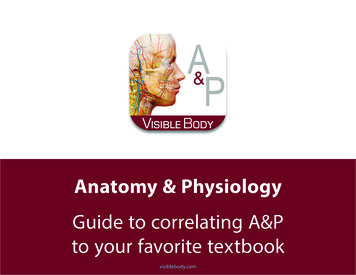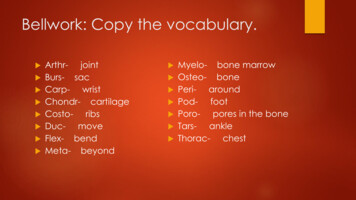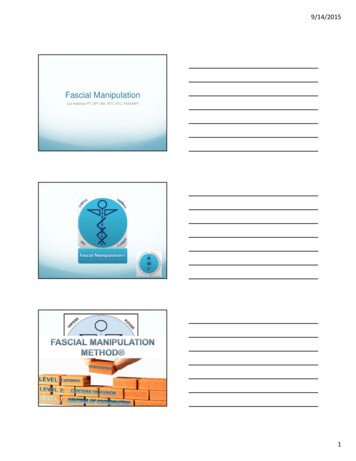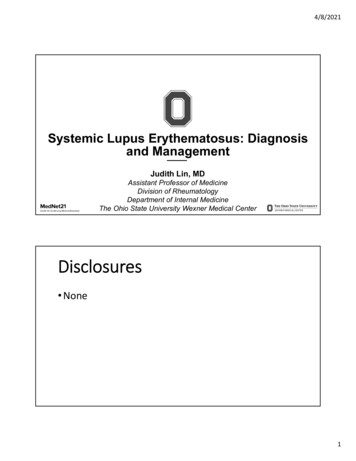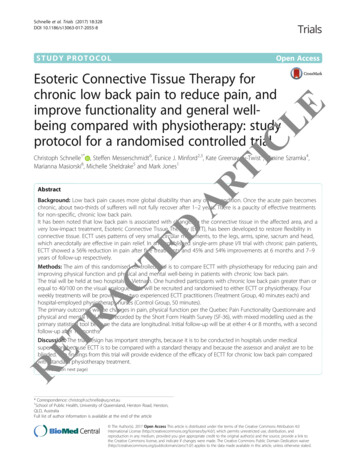
Transcription
Schnelle et al. Trials (2017) 18:328DOI 10.1186/s13063-017-2055-8STUDY PROTOCOLOpen AccessCLEEsoteric Connective Tissue Therapy forchronic low back pain to reduce pain, andimprove functionality and general wellbeing compared with physiotherapy: studyprotocol for a randomised controlled trialRTIChristoph Schnelle1* , Steffen Messerschmidt6, Eunice J. Minford2,3, Kate Greenaway-Twist7, Maxine Szramka4,Marianna Masiorski8, Michelle Sheldrake5 and Mark Jones1AbstractETRACTEDABackground: Low back pain causes more global disability than any other condition. Once the acute pain becomeschronic, about two-thirds of sufferers will not fully recover after 1–2 years. There is a paucity of effective treatmentsfor non-specific, chronic low back pain.It has been noted that low back pain is associated with changes in the connective tissue in the affected area, and avery low-impact treatment, Esoteric Connective Tissue Therapy (ECTT), has been developed to restore flexibility inconnective tissue. ECTT uses patterns of very small, circular movements, to the legs, arms, spine, sacrum and head,which anecdotally are effective in pain relief. In an unpublished single-arm phase I/II trial with chronic pain patients,ECTT showed a 56% reduction in pain after five treatments and 45% and 54% improvements at 6 months and 7–9years of follow-up respectively.Methods: The aim of this randomised controlled trial is to compare ECTT with physiotherapy for reducing pain andimproving physical function and physical and mental well-being in patients with chronic low back pain.The trial will be held at two hospitals in Vietnam. One hundred participants with chronic low back pain greater than orequal to 40/100 on the visual analogue scale will be recruited and randomised to either ECTT or physiotherapy. Fourweekly treatments will be provided by two experienced ECTT practitioners (Treatment Group, 40 minutes each) andhospital-employed physiotherapy nurses (Control Group, 50 minutes).The primary outcomes will be changes in pain, physical function per the Quebec Pain Functionality Questionnaire andphysical and mental well-being recorded by the Short Form Health Survey (SF-36), with mixed modelling used as theprimary statistical tool because the data are longitudinal. Initial follow-up will be at either 4 or 8 months, with a secondfollow-up after 12 months.RDiscussion: The trial design has important strengths, because it is to be conducted in hospitals under medicalsupervision, because ECTT is to be compared with a standard therapy and because the assessor and analyst are to beblinded. The findings from this trial will provide evidence of the efficacy of ECTT for chronic low back pain comparedwith standard physiotherapy treatment.(Continued on next page)* Correspondence: christoph.schnelle@uq.net.au1School of Public Health, University of Queensland, Herston Road, Herston,QLD, AustraliaFull list of author information is available at the end of the article The Author(s). 2017 Open Access This article is distributed under the terms of the Creative Commons Attribution 4.0International License (http://creativecommons.org/licenses/by/4.0/), which permits unrestricted use, distribution, andreproduction in any medium, provided you give appropriate credit to the original author(s) and the source, provide a link tothe Creative Commons license, and indicate if changes were made. The Creative Commons Public Domain Dedication o/1.0/) applies to the data made available in this article, unless otherwise stated.
Schnelle et al. Trials (2017) 18:328Page 2 of 12(Continued from previous page)Trial registration: Australian New Zealand Clinical Trials Registry, ACTRN12616001196437. Registered on 30August 2016.ARTI50%. Once the patient loses their job or has been offwork for 1–2 years, a return to work is unlikely [9].Almost two-thirds of newly identified CLBP patientsdo not recover within 12 months [10, 11]. For those withlonger term pain, the figure has been reported at 80%[12] including mixed primary care populations [13], with60–80% of those who consult health care providers stillreporting pain 12 months later [14–16].Cognitive factors appear instrumental in return to workrates for workers with subacute LBP; additionally, and perhaps paradoxically, going to physiotherapy has been foundto reduce the chances of returning to work [17].TreatmentsForty-eight systematic reviews, meta-analyses and guidelines [18–66] on non-pharmacological CLBP treatments,plus a special issue of Spine Journal [67], revealed notreatment that consistently provides superior results forthe treatment of CLBP. Overall positive recommendations exist for exercise therapy, massage, various formsof physiotherapy, cognitive behavioural therapy and, inparticular, a multi-disciplinary approach. The standardtreatment, physiotherapy, tends to be no better or worsethan many other treatments. Therefore, there is no goldstandard treatment for CLBP, and the search for an effective treatment continues. This is shown in the recently(November 2016) updated UK NICE clinical guidelines[65] for chronic LBP, summarised in the BMJ [68]. Notreatment is recommended for CLBP, except for radiofrequency denervation under limited circumstances.CostsACTEDBackgroundOf the 291 conditions studied in the Global Burden ofDisease 2010 Study, low back pain (LBP) rates highest interms of years lost to disability (YLD) and sixth in termsof overall burden. Because LBP has no mortality, YLDare the same as disability adjusted life years (DALYs).With a 9.4% global prevalence (95% CI 9.0–9.8), LBPcauses more global disability than any other condition.LBP has high disability weights (DW), which means thatsevere acute LBP is considered as disabling as nonmetastatic cancer or long-term stroke consequences (DW0.27, 0.32 with leg pain). The disability impact of severe,chronic LBP (CLBP) has been compared with amputationof both arms without treatment or with cocaine dependency (DW 0.37 with or without leg pain) [1].CLBP arising from ergonomic exposures at work hasbeen associated with an estimated 21.7 million DALYs in2010 worldwide [2]. The prevalence in urban Vietnam ofLBP for those aged 16 years or older was 11.2% in aWHO-ILAR study [3].Two surveys of 4000 households in North Carolina,USA found that the prevalence of chronic, impairingLBP rose significantly over a 14-year interval, from 3.9%in 1992 to 10.2% in 2006 [4]. Another survey showedthat over 10% of Australian adults had been significantlydisabled by LBP in the past 6 months [5].CLEKeywords: Chronic low back pain, Low back pain, Connective tissue, Esoteric Connective Tissue Therapy,Physiotherapy, Randomised controlled trialRETRIn Australia in 2008–2009, 1.2 billion, or 1.8% ofselected disease-allocated health care expenditure, wasattributed to back problems [6]. Contrary to clinicalguidelines, many patients with LBP start incurring significant resource use and associated expenses soon afterthe index diagnosis [7]. In the UK, the direct health carecost of back pain in 1998 was estimated at 1632 millionwhile informal care and of lost productivity add up to 10,668 million annually [8].PrognosisFor a proportion of back pain patients the prognosis canbe bleak. Once you take time off work for back pain youhave with different medical and benefit systems a 1–10%risk of not returning to work for at least a year. Notworking for 4–6 weeks leads to a 20% probability oflong-term disability and not working for 6 months reduces the possibility of returning to previous work toThe present studyThis randomised controlled trial with treatment and control groups treated in parallel has undergone a full ethicalreview by the University of Queensland’s contractor,Bellberry Pty Ltd (HREC approval number EC00444).Many scientific articles have made urgent pleas forfurther investigations, especially randomised controlledtrials, of treatments for CLBP [1, 9, 18, 24, 69, 70].To quote the most downloaded paper in the history ofPLoS Med [71], “[M]ost new discoveries will continue tostem from hypothesis-generating research with low orvery low pre-study odds.” Hence, it may be worthwhileto investigate new treatments that are currently notgiven by registered medical professionals.
Schnelle et al. Trials (2017) 18:328Page 3 of 12ARTICLEevidence that there are other influences on well-being inaddition to the physical and the psychological.However, theoretically speaking, if there are such influences, and if providers were to cultivate awareness andunderstanding of these influences, it should be possibleto design treatment modalities that work substantiallybetter than existing modalities by addressing theseimportant and heretofore unexamined influences as acomplement to the exemplary work that is done by conventional medicine.In the experience of its practitioners, ECTT worksbest when done in conjunction with the patient consulting their GP and medical specialists for any diagnostic,pharmacological or surgical interventions that could benecessary, because ECTT is not a substitute for any ofthese interventions but a complementary intervention.One corollary of taking into account what ECTT practitioners refer to as energy is that ECTT practitionersconsider the well-being of the practitioner to be of highimportance. As a result, practitioners are required toabide by a stringent code of ethics and conduct [85] thatincludes the following:“ [D]uring the life of the student/practitioner as apractising individual he and she will abstainunequivocally from pornography, the use of alcohol,recreational or illicit drugs (including all forms ofcannabis, ayahuasca and or alike [sic]), nicotine(cigarettes, cigars, pipe or alike) and/or any othersubstance that will obscure and/or alter in any waytheir conscious presence and centredness.”ECTT descriptionACTEDSuch treatments are usually referred to as complementary and alternative medicine (CAM), an ill-defined groupof treatments [72–74] with the difference between “complementary” and “alternative” rarely, if ever, defined. Forthe purposes of this article, complementary treatments aredefined as working in conjunction with and in support ofmedical professionals, and patients are not expected to reduce their frequency of medical doctor visits; in contrast,alternative treatments aim, at least in part, to replace thework of registered medical professionals.One approach may be to target the connective tissue(including fascia) because this represents a substantialpart of the body [75] and is important in enabling physical motion [76, 77] and considered to be involved inback pain [9, p. 159, 164–6, 171–2], with fascia havingrich innervation, nocireceptors and being involved inload transfer [9, p. 155, 164–5, 198]. Therefore, finding away to treat the connective tissue may influence acuteand perhaps even chronic back pain. The authors areunaware of any current treatment for LBP that specifically targets the connective tissue.A new complementary-to-medicine technique thatconcentrates on treating the connective tissue was developed by Serge Benhayon in 1999 and currently hasabout 30 practitioners. This technique is called EsotericConnective Tissue Therapy (ECTT) and is a gentle,hands-on treatment that claims to work by allowingconnective tissue in the body to soften and return to itsfluid and flexible state, which in turn decreases the compression effects on the body from tight, hard and scarredareas of injured and diseased connective tissue, therebypossibly enabling the affected body parts to resume normal, pain-free movement.RETRDescriptions of ECTT and anecdotal references are available [78–82]. The treatment consists of small circularmotions, primarily with a diameter of 2–3.5 cm, to thelegs, arms and head, with the motions to the head beingeven smaller. Further actions involve techniques for gently holding the hip, knee, ankle, back and spine, allowingthe body to adjust (align). There is some evidence thatconnective tissue undergoes changes in patients withCLBP [83]; hence, there is a possible mechanism to explain the effects of treatment of the connective tissue onnon-specific CLBP.ECTT and other modalities, such as Esoteric Chakrapuncture, Esoteric Massage, Esoteric Healing and thewomen-practitioners-only Esoteric Breast Massage, areall derived from the same underlying understanding thatenergy, a word which here includes consciousness, has astrong influence on humans. This is considered a truismin many alternative treatments [84], but clearly there isno scientific consensus or even much, if any, scientificAlthough the code is unorthodox in the categoricaland specific nature of its prescriptive rules, similaritiesexist in mainstream medicine, for example in theCatholicCare Sydney code of conduct [86].From 2006 to 2009, KG-T, a registered physiotherapistwho is also ECTT-qualified, conducted an unpublishednon-comparative, single-arm phase I/II study of the effectof ECTT for chronic pain, with participants receiving anECTT session once a week for 6 weeks. After five sessions,45 out of 51 participants reported improved pain levels onthe 100-mm Visual Analogue Pain Scale (VAS) [87–89]for pain; three participants had no change and three participants deteriorated. The average pain level moved from40.2 mm to 17.7 mm after five treatments; after 6 monthsto 22.2 mm and after 7–9 years in 2016 to 18.6 mm(standard deviations from 16.8 to 21.6 mm).This 2006–2009 ECTT study by KG-T received SouthernCross University ethical approval as a long-term follow-upstudy (Approval Number ECN-16-026).The biggest improvement in the previous ECTT trialwas from a VAS score of 80 mm to 0 mm. The worstperformances were two increases in pain scores – from
Schnelle et al. Trials (2017) 18:328Page 4 of 12TIRTEDThe primary objective of the study is to compare the results of a group of participants receiving four sessions ofECTT with the results of another group of participantsreceiving four sessions of conventional physiotherapytreatment, with one session given each week, to determine whether ECTT results in greater improvements inpain reduction compared with the control treatment.The scales to be administered are the VAS, the QuebecBack Pain Disability Scale and the two main scales of theSF-36, the Physical Component Summary and MentalComponent Summary.The Quebec Back Pain Disability Scale [92, 93] (hereafter Quebec scale) is a 0–100 scale asking 20 questionsand measures functional disability “in terms of perceiveddifficulty associated with simple physical activities” [93].The 0–100-mm VAS is anchored at 0 and 100, where0 signifies no pain and 100 agonizing pain. One study[94] has argued that the minimum clinically significantdifference (“a little better”, “a little worse”) is 12 mm; another has used 18 mm [95]. A third study [96] used a literature review, an expert panel and a workshop to cometo the conclusion that the “minimal important change”for VAS is 15 mm and for the Quebec scale is 20 points,while a 30% improvement on either scale was considered“clinically meaningful”. Because this latter study hasbeen the most thorough evaluation, we will adopt theirdefinitions of minimally clinical importance and clinically meaningful change.The SF-36 [97] has eight scales. For three of thesescales, the following minimum clinically important improvements were calculated: Physical Component Scale,2.0; Bodily Pain, 7.8; and Physical Function, 3.3 [98].This trial adopts these values as minimum clinically important improvements.APrimary objectiveMeasurementsCLEAustralian NHMRC “National Statement on Ethical Conduct in Human Research 2007 (Updated May 2015)” [91].A brief Standard Protocol Items: Recommendationsfor Interventional Trials (SPIRIT) flow diagram isprovided in Fig. 1, and a populated SPIRIT checklist isprovided in Additional file 1.a score of 30 mm to 50 mm and from a score of 50 mmto 70 mm. The improvements in this study could be dueto many influences, including the placebo effect, regression to the mean or other reasons. However, the result,if it turns out to be representative, would be among themore promising outcomes available, especially in light ofthe low-intensity nature of the intervention.Because the previous study is a single-arm phase I/IIstudy evaluating safety and efficacy, the next step is toperform a randomised controlled phase III study comparing ECTT with standard therapy.SM and another practitioner of ECTT with 8 years ofexperience each in ECTT have been voluntarily offeringECTT treatments at two hospitals (Pacific Hospital, HoiAn and Pacific Hospital, Tam Ky) in central Vietnam,near Da Nang, over the last 4 years, and the administrator of both hospitals has indicated his willingness to provide the facilities and resources for a randomisedcontrolled trial comparing ECTT with the standard physiotherapeutic hospital treatment of CLBP.Secondary objectivesETRACSecondary objectives of the study are to compare foursessions of ECTT with four sessions of conventionalphysiotherapy treatment to determine whether ECTTresults in larger improvements in physical and mentalhealth as measured by the Short Form Health Survey(SF-36, a general well-being questionnaire), and in painfunctionality as measured by the Quebec Back Pain Disability Scale, compared with the control treatment.A further secondary objective of the study is to seewhether any treatment effect differs between patientswith initial moderate and high pain levels.RMethodsInterventionEsoteric Connective Tissue TherapyThe treatment consists of small circular motions, primarily with a diameter of 2–3.5 cm, to the legs, armsand head, with the motions to the head being evensmaller. Further actions involve techniques for gentlyholding the hip, knee, ankle, back and spine, allowingthe body to adjust (align).Trial designThis is a randomised controlled trial of four weekly sessions of ECTT with follow-up after either 4 or 8 monthsand a second follow-up after 12 months. Measurementswill be taken at baseline, before each session and at thefinal follow-up. The measurements will be made by staffat the hospital who are blind to the treatment and groupassignment, and not by the practitioners or researchers.The protocol conforms to Principles 1–8 of the NIHTask Force on research standards for CLBP [90] and theParticipantsThe study population will be individuals who present during the trial period to a participating hospital as outpatients, who are over 18 years old, are not pregnant, arehealthy enough to receive standard physiotherapy treatment, consent to be part of this trial and do not meet theexclusion criteria. The participants will not be charged forthe treatments. The physical requirements for ECTT arelower than those for standard physiotherapy treatment;
Schnelle et al. Trials (2017) 18:328TEDARTICLEPage 5 of 12Fig. 1 SPIRIT flow diagram of the Esoteric Connective Tissue Therapy for chronic low back pain studyETRInclusion criteriaACtherefore, any patient who is capable of receiving thestandard physiotherapy treatment is also eligible to receiveECTT. For consistency, the physical requirements are thesame for both groups.Ri. Aged 18 years or older, able to speak, read and writein Vietnamese.ii. Suffering from CLBP, which, according to the NIHTask Force’s definition [90] is pain for at least half ofthe days in the past 6 months.iii. At evaluation time, suffering from LBP at aminimum of an average of 40 out of 100 on the VASfor the previous 7 days because memory issues mayappear for longer recall periods.iv. Physically able to undertake the standardphysiotherapy treatment given by the hospitals.v. Able to complete the SF-36 questionnaire, either independently or with help from the hospital staff.Exclusion criteriai. Being pregnant or uncertain of pregnancy status.ii. Having a clinical diagnosis of schizophrenia, bipolarconditions and/or states including mania, delirium,psychosis or any signs of psychosis, borderlinedisorder or major depressive disorder.iii. Diagnosed or suspected neoplasm.iv. Past surgery to the spine.v. Osteoporotic fracture, neoplasm or infection,which applies to approximately 5–15% of CLBPinstances [99].Withdrawal criteriaPatients who withdraw after the end of week 2 will notbe replaced, because the replacement would be unableto participate in four sessions. Patients who withdrawwill receive normal hospital care as determined by theirphysician.Discontinuation criteria for individualsi. Becoming pregnant.ii. Becoming too ill to continue.iii. Electing not to continue.
Schnelle et al. Trials (2017) 18:328Page 6 of 12The collated data will be stored in de-identified formfollowing the Stanford University Guidelines for electronic data collection and storage inuation criteria for parts of the trial or the entiretrialThe trial will be stopped if a serious adverse event occurs, where ECTT is deemed to be responsible for theadverse event or where the preponderance of the evidence points to ECTT being the source.To quote the Australian National Statement on EthicalConduct in Human Research [91], “Serious AdverseEvents” are defined as untoward medical occurrencesthat result in death, are life-threatening at the time, require inpatient hospitalisation or prolonging of existinghospitalisation, result in persistent or significant disability/incapacity or are medically important events orreactions.TITEDImportant protocol modifications (e.g., changes to eligibility criteria, outcomes, analyses) will be reported to therelevant parties (investigators, trial participants, trialregistry, ethics committee, journal) either immediately(investigators, trial participants) or at the time a reportis due (trial registry, ethics committee, journal).ATrial modificationsThe study is a two-group, stratified, randomised,controlled study with at least 50 individuals each in aTreatment Group and a Control Group.Patients who visit the hospital for treatment will beevaluated for their suitability for the trial and, if theyare suitable and agree to participate, they will beassigned randomly to the Treatment Group or theControl Group.The Treatment Group will receive ECTT sessions, andthe Control Group will receive the conventional doctordirected treatment, which in this design is the standardphysiotherapy administered by hospital-employed physiotherapeutic nurses. The trial will use two practitionersfor the ECTT Treatment Group only, because it is possible for a practitioner to treat 10 patients a day for40 minutes each.The stratification will be by pain level according to theVAS, with one stratum for moderate levels (40–59 mm)and another for high levels (60 mm).RAdverse eventsAdverse events are recorded as part of the data collection for each session and will be reported to the clinicalauthorities and to the ethics committee. Participants suffering adverse events will receive free hospital care totreat the adverse event.CLEProcedureCData collectionETRAThe data will be entered twice by data entry personnelwithout identifying which are Treatment Group dataand which are Control Group data and will then becompared and corrected. The statistician will then perform a number of logical and range checks and will sendqueries to the data entry personnel.Subject confidentialityRAll data will be recorded on paper and only onedocument will contain both the patient ID and thename and address of the patient. This document willbe held by the hospital. All data entered into a computer will be in de-identified form and the data willbe stored in a password-protected Microsoft Excel fileand a password-protected pdf file. The statisticianand any subsequent data analyst will only have accessto the de-identified data.The electronic de-identified data will be held indefinitely by the researchers for future meta-analysis and willbe made accessible on a case-by-case basis with full orreduced demographic and diagnosis data depending onthe circumstancesRandomisationFor allocation, the researchers will use the website“Sealed Envelope” [100] with a block randomisation design (block size 4, 6 or 8) for 160 subjects and an overallsoft limit of 100 participants. The seed used for the randomisation will be 8. The allocations will be put in 200envelopes, which is a sufficient number in the unlikelyevent that an overwhelming proportion of participantsare from one pain strata only. The envelopes will bemarked with their pain-level stratum (moderate or high)and sequence number. The envelope will contain thegroup designation, with group A being the ECTT Treatment Group and group B the Control Group.Once a participant has been accepted into the trial,the researcher will create a photograph of the selectedbut unopened envelope together with the paper list ofparticipants that does not have the new participant’sname on it. The researcher will then open the envelope and add the participant to the list and makeanother photograph of the list. This system of photographs is used to avoid a phenomenon in which theclinician wishes to assign participants to a particulartreatment and opens more than one envelope beforeassigning a participant to ensure that the participantends up in the clinician’s preferred treatment groupfor this participant.
Schnelle et al. Trials (2017) 18:328Page 7 of 12BlindingProceduresACTEDARTIInterventionsThe Control Group will receive the conventional doctordirected treatment, which in this design is standardphysiotherapy consisting of four weekly 50-minute sessions that use some combination of deep tissue massage,a TENS machine, electro-acupuncture, a vibrating handheld massage tool and a heat lamp Additional file 2. Thecontrol treatment will be provided by physiotherapeuticnurses. None of these treatments are recommended forCLBP [65], partly because, except for radiofrequency denervation, no intervention is recommended for CLBP[65], although massage is recommended for acute LBPand acupuncture/TENS is a popular treatment with3000 studies of the technique [101]. There are nopersonnel available who are qualified in both ECTT andphysiotherapy, hence the intervention and control treatments are provided by different practitioners. There is apotential confounding effect in having different practitioners but this setup avoids the possibility that the practitioners may have a bias towards either technique andwould treat accordingly.The ECTT treatment will follow the techniques provided in the ECTT training manuals [102, 103] as described earlier under Background/ECTT description.the patients are eligible to be part of the trial, they willbe given the patient information and consent form toread and, if they approve, to sign.As a next step, the patients will be assigned randomlyto the Treatment or Control Groups and asked tocomplete the SF-36 and the Quebec scale. Each participant will then receive four weekly sessions of ECTT orthe standard physiotherapy treatment. At the beginningof each treatment, each patient will be asked by an administering nurse to indicate their pain levels on theVAS. One week after the fourth and last session, all patients will be contacted by a nurse who is unaware oftheir group assignment. The nurse will record their painlevel and give the patients the SF-36 and the Quebecscale to complete.The treatments will take place in a large room withnurses and three translators present. The practitionershave also learnt some Vietnamese so that they can givesome feedback to the participants if needed; for all othercommunication, a translator will be used.The next time the ECTT practitioners visit, either inMarch or July, the first follow-up survey will be done. Atthe second visit, the second follow-up survey will be administered. The participants will receive no treatment aspart of this trial during the follow-up visits.The following treatment protocol will apply to thecontrol group and will be administered by Vietnamesephysiotherapy-trained nurses:CLEThe physical setup of the trial does not allow blinding ofthe practitioner or the patient. The final assessment aweek after the last treatment, and the follow-up assessments, will be done by a person blinded to group allocation and treatment. The statistician performing thestatistical analyses will also be blinded to group allocation and treatment.RETRThe hospital will contact its CLBP patients and advertisein a local newspaper and by SMS that foreign practitioners are available to offer back pain treatments. Thisis a normal occurrence; for example, surgeons from theUS perform free cleft palate and cleft lip operations onceor twice a year at the hospitals participating in the study.Additional participants are expected through word ofmouth from patients who previously received ECTT andfrom the examination and emergency ward of the participating hospitals.The recruited patients will be referred to the Rehabilitation, Physiotherapy and Natural Medicine Scienceward, where both groups will receive their treatments.A medical doctor at the ward will collect data on thepatient’s age, gender, height, weight, level of education,chronicity (duration of chronic pain) assessment,whether they have been off work for more than 1 month,other pain sites and the inclusion and exclusion criteria,which include their current level of LBP on the VAS. IfMassage for 15 minutes.TENS machine for 15 minutes.Electro-acupuncture with UV heat lamp for20 minutes.The TENS machine, the electro-acupuncture and theheat lamp are set at the highest level the patient iscomfortable with.Outcome measuresOutcome measures have been selected based on thosechosen for previous trials of interventions on LBP[24, 104–107].Primary outcome measuresThe primary outcome will be change in pain levels frombaseline to the last treatment, and at follow-ups after 4or 8 months and after 12 months (two follow-ups).“Pain” is defined as overall average
Background: Low back pain causes more global disability than any other condition. Once the acute pain becomes chronic, about two-thirds of sufferers will not fully recover after 1-2 years. . Esoteric Healing and the women-practitioners-only Esoteric Breast Massage, are all derived from the same underlying understanding that energy, a word .


